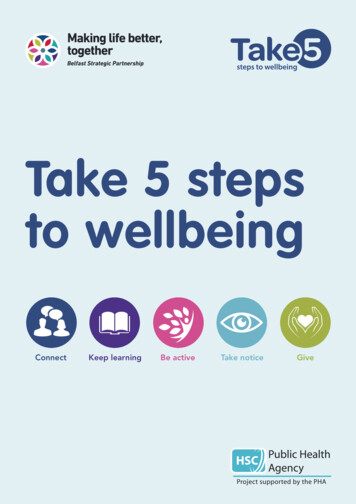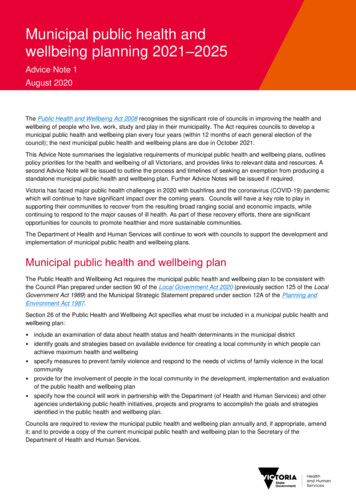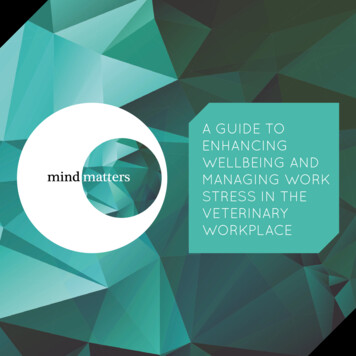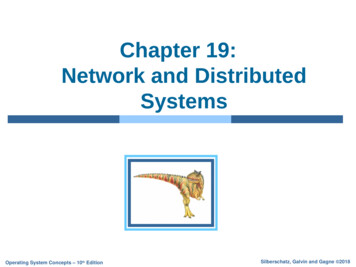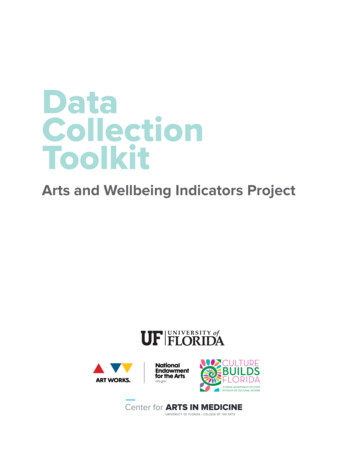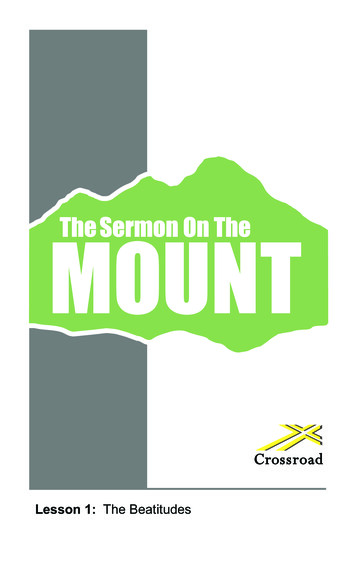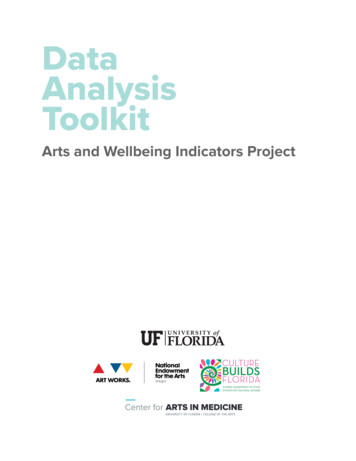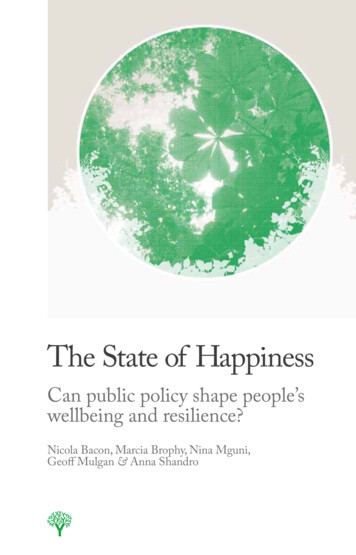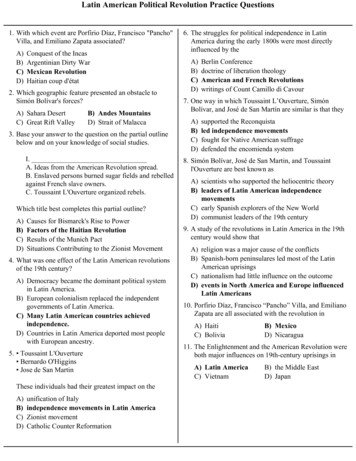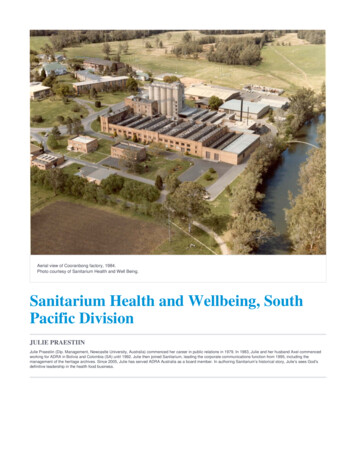
Transcription
Aerial view of Cooranbong factory, 1984.Photo courtesy of Sanitarium Health and Well Being.Sanitarium Health and Wellbeing, SouthPacific DivisionJULIE PRAESTIINJulie Praestiin (Dip. Management, Newcastle University, Australia) commenced her career in public relations in 1979. In 1983, Julie and her husband Axel commencedworking for ADRA in Bolivia and Colombia (SA) until 1992. Julie then joined Sanitarium, leading the corporate communications function from 1995, including themanagement of the heritage archives. Since 2005, Julie has served ADRA Australia as a board member. In authoring Sanitarium’s historical story, Julie’s sees God’sdefinitive leadership in the health food business.
The Seventh-day Adventist Church’s Health Food Department in the South Pacific Division, referred to as SanitariumHealth & Wellbeing Group, owns a number of innovative health food and health and wellness operations.1 This groupof pioneering entities share a vision to improve the health and well-being of communities in Australia, New Zealand,and globally, in the context of the church’s religious, charitable, and educational work. The group includes: SanitariumHealth Food Company – Australia and New Zealand; Life Health Foods Australia, New Zealand, India, and the UnitedKingdom; Vitality Works Australia and New Zealand; Lifestyle Medicine Institute; and the Complete HealthImprovement Program (CHIP).Originally inspired by the counsel of Ellen G. White on plant-based foods and healthy living, the company is nowunited under its purpose of “changing lives every day through whole person health.”The Beginnings of Health ReformThe Seventh-day Adventist Church grew out of the Great Advent Awakening of the eighteenth and early nineteenthcenturies, and the Millerite movement of the 1840s in the United States of America.2 It was formally organized in 1863in Battle Creek, Michigan.James and Ellen White were among the church’s early leaders.3 It was believed that Ellen White received directionsfrom God, and she became a prolific writer and vocal leader of the rising church.4During these years Americans developed a growing interest in health,5 with practices such as water treatments6 andvegetarianism being introduced.7 During White’s early visions in the 1840s and 1850s she was shown the detrimentaleffects of many common lifestyle habits of the time, such as overeating, rich foods, and the use of such drugs andstimulants as alcohol, tobacco, tea, and coffee.8 She began to adopt these new health ideas following several familyhealth problems. In the winter of 1862–1863, two of the Whites’ sons were struck down by diphtheria, but fortunatelyEllen and James had read a newspaper article by Dr. James C. Jackson on water treatments for the disease, andtook the recommended actions. As a result, the boys’ lives were saved.9On Friday evening, June 5, 1863, Ellen White received a vision from God in which she was shown that eating meatwas also discouraged because of the increase in animal diseases.10 Regular exercise, pure water, and fresh air wereessential for maintaining and restoring health.11 In December of the same year, her eldest son, Henry, died ofpneumonia after being given drugs by a doctor who followed the usual medical practices of the day.12 Three monthslater, in February 1864, younger son Willie also contracted pneumonia.13 This time his parents decided to follow thedirections for hydrotherapy treatments, and after diligent care by his parents, Willie White recovered.14Her family’s experience with illness led White to seek more understanding of healthy living.15 She continued to publishher written work on the subject of health and speak about her visions and counsel.16 Gradually the Seventh-dayAdventist church members began to practice these health ideas and adopted them as their preferred lifestyle.17Health Education FormalizedIn May 1866 the Seventh-day Adventist Church, at the urging of Ellen White, proposed the development of a healthinstitute and purchased a nine-acre (3.6-hectare) property in Battle Creek, Michigan. It opened as the Western HealthReform Institute in September 1866.18 In 1876 the church appointed 24-year-old Dr. John Harvey Kellogg to takecharge of the institute.19 He introduced numerous reforms and placed the health program on a more scientific base.He changed the institute’s name to Battle Creek Sanitarium, defining the newly coined word “sanitarium” as “a placewhere people learn to stay well.”20The health program emphasized a healthy, preferably vegetarian diet, exercise, fresh air, water and musculartherapies, massage, good posture, and abstinence from alcohol and tobacco.21 Concerned that many Americans’poor health was largely owing to poor diet, Dr. Kellogg focused on producing healthy foods that helped to improve hispatients’ health. The first he called Granola, which was a mixture of cooked grains.22New Health Ideas for a New NationIn 1885 the church leaders in Battle Creek sent a small group of Seventh-day Adventist ministers and workers to startthe work of the church in Australia and spread the health message.23 As the fledgling church began to grow, EllenWhite, at the suggestion of S. N. Haskell,24 was requested to visit Australia to give advice and strengthen its work. InDecember 1891, at the age of 64, she arrived in Sydney with her son William (Willie), with the intention to stay nomore than two years. They stayed for nine.25In 1894 she was invited to talk about the health work and her visions of health reform at Brighton church’s campmeeting in Melbourne, the first camp meeting held in Australia.26 The meeting proved popular, as the original order offorty tents had to be increased to 102 to cope with demand.27 It was here that church members in Australia were firstintroduced to the idea of developing a health food factory in Australia.28 On January 7, 1894, Ellen White spoke of thealarming extent to which poor health would grow.29 Mrs. M. H. Tuxford and a young George S. Fisher were amongthose who heard her speak and would become instrumental in spreading the health messages she espoused.30
Enthusiasm for Health FoodInspired by White’s lecture, a Mrs. Press asked her to share her knowledge. Mrs. Tuxford and her friend Mrs. Starrbegan giving cooking lessons in homes around Melbourne, including those of Mrs. Press and her friends.31An enthusiasm for the health reform began to grow through the Adventist Church community, and members beganthe preparation and sale of their own health foods in other states of Australia.32 Willie White, Australia’s first AdventistChurch union president, was concerned about the opening of independent operations without sufficient knowledge orability, which put the reputation of the health movement at risk. He wrote to the church leaders in Battle Creek,seeking their assistance in advancing the health work in Australia in an organized manner.33An Accidental SecretMeanwhile, at Battle Creek Dr. John Harvey Kellogg and his brother Will Keith Kellogg were busy experimenting withcooking new grain products to make a variety of healthy foods, suitable not only for breakfast but other meals as well.One of the most common medical complaints at that time was “dyspepsia,” a term used for a range of digestivecomplaints. Dr. Kellogg saw a need for a grain-based health food, believing that precooking the grains to break downthe starch would aid the digestive processes of his patients.34The Kellogg brothers had been unsuccessfully trying to process cooked wheat grains by squeezing them betweentwo eight-inch rollers. The resulting mush stuck to the rollers and had to be scraped off.35 Then, in April 1894, theyhad cooked a batch of wheat, but before it could be rolled, the men were called away. It was not until the Saturdayevening that the Kelloggs returned to their experiment. The cooked wheat grains had gone moldy, but undeterred, thebrothers decided to try rolling them anyway. To their surprise, large, smooth flakes emerged through the rollers andwere easily peeled off with the knife, ready to be placed in the oven for drying and crisping.36 They had discoveredthis secret to success by accident: if they tempered the cooked wheat to allow moisture to move evenly through thecooked grain, then the grain could be easily rolled, with the individual flakes preserved and ready for baking.37On May 31, 1895, Dr. Kellogg filed an application to patent the process of preparing flaked cereals from wheat,barley, oats, corn. and other grains, which was granted on April 14, 1896.38 They named the new wheat-flake productGranose,39 and it was also soon available as cereal biscuits,40 revolutionizing breakfast in the Western world. By 1906Dr. John Harvey Kellogg and Will Keith Kellogg went their separate ways, with younger brother Will establishing hisown cereal empire, Kellogg’s Cereal Company.41Meanwhile, the early Seventh-day Adventist community in Australia, encouraged by Ellen and Willie White in healthyliving, were eager to access Dr. Kellogg’s nonmeat products.42Initially they received cases of health products from America,43 but the need for local production was apparentbecause of the challenges of importing products that would keep over such a long journey.44 In February 1895 publichealth lectures were given for the first time in Australia, at the Women’s Community Temperance Union Hall andrestaurant in Melbourne.45 This generated great interest in health foods, particularly those imported from Battle Creek.These always landed stale, and the duty and expense of the transportation added so much to the cost that they hadto be sold either at a high retail price or a loss.46Formalizing the Health Food WorkIn 1895 Willie White approached the church’s Executive Committee regarding organizing the emerging health foodwork. The committee resolved to commence the establishment of bath-houses and depots for the supply of healthfoods. Then, a year later, the committee decided that the time had come to formalize a health food business.47At the Hobart church camp meeting in November 1895, White explained that the health food business would be amissionary agency. He opened a packet of Granose and passed it around for people to sample. The members werequick to request its importation.48Following the General Conference session held in Nebraska in 1897, White scouted America for machinery andexpertise to establish the company in Australia.49 Growing interest in health foods led White to consider employing abaker in Australia to start the manufacture and sale of health foods. In early 1897, when he went to the church’sGeneral Conference meeting at Battle Creek, he looked for an experienced baker,50 although he was unsuccessful.At that time George S. Fisher was given the task of costing the imports and selling them.51In October 1897, at the first camp meeting held in New South Wales (in Stanmore, Sydney), Dr. Edgar Caro gave aseries of health lectures and, together with vegetarian fare offered at the dining tent, stirred further interest in healthfoods.52 At the same camp meeting, on October 31, 1897, the first meeting of the Australasian Medical Missionaryorganizing committee was held. This newly formed committee’s purpose was to establish the Australian MedicalMissionary and Benevolent Association, which was to be advisory, educational, and charitable. It would haveoversight of the Sanitarium Hospital in Sydney, the health food business, and charitable activities of the church.53 Atthis first meeting, the committee recognized the establishment of bakeries and agencies for the sale of health foodsas one of its most pressing tasks.54
Willie White placed a large order with Battle Creek and wrote asking American baker Edward C. Halsey, trained at theBattle Creek Sanitarium,55 to come to Melbourne to supervise the preparation of the products.56Sanitarium Health Food Company Is BornSix weeks later the medical missionary organizing committee unanimously agreed to name the organizationSanitarium Health Food Agency, a nod to its Battle Creek beginnings.57 Invited by the union conference committee,E. R. Palmer became the first manager.58Edward C. Halsey arrived in Sydney on November 8, 1897. He first visited the Avondale College and then cooked atthe Melbourne camp meeting. Halsey enthusiastically searched for a suitable bakery, while sourcing baking and otherequipment to make the foods.59 Meanwhile, the committee struggled to find a suitable location and to purchase theright equipment, some of which had to be bought from America. The search took a couple of months, but finally, onJanuary 27, 1898, in the St. George’s bakery in Northcote, Melbourne, Halsey began making Australia’s first peanutbutter and cereals such as Granola, a ready-to-eat porridge.60 Just three months later, on April 27, 1898, theSanitarium Health Food Agency was registered as a business.61During this time things were grim as the Australian colonies were suffering severe economic depression. Australiawas passing through the most serious financial crisis it had experienced, and Melbourne had been particularly hardhit from the failure of the land boom and reconstruction of the banking industry.62 Health food was an entirely newidea, and management had very little money available, with an inferior plant for their purpose and the problem ofcreating demand for new and unknown products. They did not have means for advertising, yet needed to make salesto keep the business going.63When Granola, the main product at the time, was placed on the market, it was deemed expensive by a public thathad yet to appreciate the value of health foods, and when compared with more traditional breakfast foods available64(like toast and eggs). The price was dropped, and this helped slightly. Small shipments were sent to other states, andsome products were sold through retail stores in Melbourne, but some packets stayed on the shelf so long that theybecame prone to insects, which attracted complaints.65However, there was a desperate need for working capital if the venture was to survive.66 Management took out a loanof 500 for operating money,67 but it became evident that there was no market for the new products.68 The situationwas so desperate that even the bakehouse staff were forced to close the bakery and go out to sell their products. TheAdventist Church’s Tract Society offices were also asked to promote and sell the products. Finally, the Health FoodCommittee decided to appoint door-to-door salesmen.69Against All OddsLater in 1898 William White and the union conference committee arranged for the appointment of George W. Morse,who had experience in the health food business in the United States, to take charge of the health food enterprise andassist in increasing sales in Australia.70 Meanwhile, the first bakehouse in Northcote was proving unsatisfactory.71 ByAugust 15 it was decided that the food business needed to find new premises as a means of providing better facilitiesfor manufacturing and distribution. Various locations were looked at in Victoria and New South Wales.72On September 7, 1898, the location committee, including A. G. Daniells, W. C. White, Dr. E. R. Caro, G. W. Morse,and E. R. Palmer, agreed to move the health food business to a property where there was suitable and affordableland adjacent to Avondale College in Cooranbong so that it could be connected to the school and the new buildingsfor care of the sick.73 Here new products would be tried, tested and implemented74 and would provide work forstudents at the college.75The college provided student labor, opportunities to use the school facilities for training, and room to expand. Thecommittee acknowledged, however, the problems of sourcing raw materials and transporting the finished goods.76The raw materials were to be transported by barge from Dora Creek railway station up the creek and offloaded at awharf nearby. The manufactured product was then transported back to the train station.77The move was made to Cooranbong under the direction of Philip Rudge. The existing sawmill on the property waspurchased and converted into the new bakery, saving considerable expenditure in constructing a new factory.78 Itrequired a brick addition for which 65,000 bricks were produced over five months on college property. The equipment,including a reel oven, boiler and engine, and numerous mills, required a capital expenditure of nearly 400.79Ellen White expressed her concerns for the industry: “We needed health foods, but we had no money to purchasematerial or machinery with which to prepare them. . . . We had not numerous churches to draw upon [unlike the workin the United States].80
In November 1898 work on converting the old sawmill to house food production was delayed. Making the bricks usingthe clay from the estate had taken much longer than planned. A shortage of funds and insufficient arrangement forcredit to meet the immediate needs of the business meant there was no money to purchase the necessary ironfittings and pipes for the ovens. Management decided to visit an engineering and foundry firm in Newcastle to ask ifthey were willing to supply all the iron work. This request was successful and the building was completed; atemporary respite.81For six months none of those engaged in the work drew any cash or any wages, and the prospect of securing fundsto continue was uncertain. However, those pioneers who engaged in the business did so believing they were “doingGod’s service” and showed a spirit of determination to overcome against all odds. They worked long hours withmeager facilities, and often did not receive their small wages for months.82 Operations at the factory dependedentirely upon money that came from church members.83Praying for a MiracleDuring this period A. G. Daniells, president of the union conference, struggled with the problem of debt. He went toMelbourne, where he found the church administrators hard pressed to find funds to repay loans. They decided to visitthe bank. On arrival they found it closed for the day; however, on closer inspection they noticed a door wasmiraculously ajar, so one of the men pushed the door open and they went inside. A loan was negotiated with thesurprised bank manager, on the honor of one of the brethren and without any security whatsoever.84Following this, a special appeal was made to the Seventh-day Adventist community, and sufficient funds weredonated to cover the immediate needs of the work. After that, money trickled in, while there was a slight but steadyincrease in sales.85 By the following year, E. R. Palmer reported that manufacturing now included Granose biscuits,Granose flakes, Bromose, Nuttose, antiseptic tablets, Granola, Caramel Cereal, nut butter, wheatmeal biscuits, glutenbiscuits, gluten meal, and still other foods that are in the experimental stage.86 Avondale Health Retreat, which wasopened in December 1899, did not use animal products in its dining room, but healthy foods manufactured bySanitarium.87Dr. John Harvey Kellogg proposed to remit all royalties if the food business was placed under the Sanitarium Hospitalboards, so in 1900 Sanitarium Health Food was placed under control of the Australasian Medical Missionary andBenevolent Association.88 Later, when the factory came under control of the college, the issue was raised as towhether the company was bound to pay royalties on Granose.89Of this health food work, Ellen White counselled: “In all our plans we should remember that the health food work isthe property of God and this it is not to be made a financial speculation for personal gain. It is God’s gift to His peopleand the profits are to be used for the good of suffering humanity everywhere.”90Laura Lee Inspires Sales to the PublicIn November 1899 Miss Laura Lee, who had spent time in the home of Ellen G. White and had been a cook in thehome of Willie White, attended the Maitland church camp meeting.91 She observed the health food exhibition tent,sampled the food provided, and heard of the formal decision to start up a food bureau.92Following the camp, Sanitarium opened a health food shop in the town of Maitland, selling health foods and offeringhealth advice, under the management of G. W. Morse and with the help of Miss Lee.93 As “a thoroughly accomplishedyoung lady, whose heart is thoroughly in the business,”94 the board was keen to retain her services,95 but after threemonths she returned to the Sanitarium Hospital in Summer Hill, Sydney, to complete her studies in nursing, and theshop was closed.96 However, the experience in Maitland was a precursor to the health food shops that later appeared.Health Foods for New ZealandDuring these early years interest in the health food work had also begun to grow in New Zealand. G. A. Brandstaterinitially established a health home in Linwood, Christchurch, which was soon moved to Papanui. There he was joinedby Dr. Frederick Braucht, a former colleague of J. H. Kellogg.97 Dr. Braucht requested of the Australian Sanitariumboard that it send him a baker to help prepare health foods for the Home.98 Edward Halsey accepted the invitation,arriving in Christchurch on January 11, 1901. At the New Zealand church camp meeting in Christchurch that samemonth, the managing committee for the Medical Missionary and Benevolent Association confirmed the purchase ofthe property at Harewood Road, Papanui. Halsey relocated there and established his bakery in a small, red woodenshed behind the Health Home.99As soon as he was able, Edward Halsey started making Granola, Caramel Cereal, unleavened rolls, and bread foruse in the health home.100 Sidney H. Amyes, a wealthy farmer, was so keen to see the enterprise grow that he fundedthe purchase of a small oven, which cost 55, and later became the unpaid manager, working alongside Halsey.Amyes was a man of vision: he was determined that New Zealanders should have access to the products that weregaining prominence in the United States.101Amyes and Halsey made a formidable team, building the fledgling business first through church members, then
bringing the products to the public through grocers.102 By 1922 a new factory had been built in Christchurch.103Health Food Café in Sydney, AustraliaIn March 1902 a café was opened briefly in Royal Arcade, Sydney, and attracted passersby to sample the healthfoods being promoted. By March this had moved to nearby premises at 283 Pitt Street for a rental price of 10 aweek and was managed by John Burden. Known as the Pure Food Vegetarian Café, Mrs. Tuxford and Miss Leeoperated the restaurant. On the first day 25 meals were served, but in a short time as many as 88 meals were servedon an average day.104 A sample meal of the day’s menu was displayed in the window, and health foods wereavailable for purchase from a small counter, marking the start of the retail branch of the company.105During her nursing training, Laura Lee had met Carl August Ulrich and married him soon after they completed theirstudies. Both now trained as Sanitarium nurses, they opened treatment rooms adjacent to the café, giving massagesand other remedial treatments to patrons.106 Laura Lee developed healthy recipes, special instructions to preparehealth foods, and an explanation of the health benefits, later publishing a book of her recipes.107In March 1904 the café moved to larger premises located in the basement of the Royal Chambers at 45 HunterStreet, on the corner of Castlereagh Street. Formerly it had been a Cobb and Company coach stable and therenovations cost 150.108George Fisher’s LeadershipJust as the finishing touches of the refurbishment to the café were undertaken, George Fisher was appointedmanager of the café and retail stores. He relocated to Sydney from Melbourne, where he’d been working at the BibleEcho Publishing Company.109The café opened early in March, with a daily patronage of 60 to 70 people. However, there were no funds topurchase so much as floor coverings, and Fisher was told by the union conference that the business would have tosink or swim. According to Fisher, the workers were so committed to the work that they determined, with God’s help,that they would carry on and not suffer defeat.110 Gradually the café’s ailing finances began to improve, and withstrenuous efforts George Fisher and his staff turned it into a profitable business.111Fisher’s success was based on his passion for what he had first heard from Ellen G. White at the Brighton camp inMelbourne, and his ability to lead people and business. Fisher had a vision of what the business could become.112 Hewrote: “Every penny was turned over more than once before it was spent. Coconut runners were laid instead oflinoleum. We purchased a two-wheel hand cart, and we would push it along Pitt Street in the early hours of themorning, filled with vegetables. We swept our own chimney on a Saturday night. But all the workers were so deeplyinterested in the success of the work that they did not mind what they did.”113The staff members met in the office just before the midday meal each day to have prayer, asking the Lord to givethem grace to be good witnesses to the customers and for operations to run smoothly. They also voted to reducetheir wages so that expenses could be met, without reference to the board.114 Reporting favorably at the end of thefinancial year, Fisher stated that the daily average number of meals served had started at 90, but by the end of thefinancial year had risen to nearly 200, with the daily record being 204 meals.115Mail orders began in 1905, after a man visiting Sydney from 300 miles (482 kilometers) away was so impressed byhis meal at the café that he requested a dinner to be sent by rail. Over several months a number of agencies wereestablished in various parts of New South Wales to fill mail orders for health foods.116 In 1908 Fisher asked Laura Leeto return to the Sydney café as matron. She and her husband had returned to Tasmania a few years before becauseof his illness, and after his accidental death in 1904 she had opened a café in Hobart.117 Knowing the benefits ofpersonal contact and interaction with customers in the café and heeding Ellen G. White’s advice to “let them learnhow to live healthfully, teaching to others what they have learned,”118 George Fisher asked Laura Lee to train his caféstaff and give lectures, demonstrations to the public on nutrition, and the preparation of healthy meals.119 As caféswere established in other cities, Lee was called upon to give help and cooking demonstrations, and she alsoexperimented with new foods at the Avondale factory. Her expertise was a valuable contribution to the health foodwork of the company.120After showing his considerable capabilities in café management, George Fisher was elected as the secretary of thehealth food work and given the position of factory manager at Cooranbong in 1910.121 He was instrumental duringWorld War I in procuring much-needed supplies to keep the work of the factory going.122George Fisher was known as “the father of the health food work.” He considered it his privilege to have a part infulfilling the health ministry vision, throwing his whole life into the health food business. Members of his family recallthat during those years he was always busy “doing the work of the Lord.”123First Profits to the MissionsThe café work continued to grow. In the beginning the patronage was predominantly businessmen, but many of themwere so impressed that they began convincing their wives of the Pure Food Café’s culinary benefits. Cooking classeswere started, and in turn more ladies would lunch at the café, so patronage increased.124 The need to expand
became evident. After Fisher and his staff made it a matter of prayer, an opportunity to acquire the Catholic repositorynext door provided space for a further 25 to 30 people.125To celebrate the opening of the new extension on August 19, 1906, the café staff prepared a dinner for more than100 church members.126 They were well aware of Ellen White’s counsel: “In all our plans we should remember thatthe health food work is the property of God and that it is not to be made a financial speculation for personal gain. It isGod’s gift to His people, and the profits are to be used for the good of suffering humanity everywhere.”127 During theceremony George Fisher stood up and read a recommendation by the union conference council in Melbourne, urgingthat conference committees and institution boards make “a donation toward foreign mission work” from “ordinaryincome.” Fisher went on to say that the “café family” had “united in practising economy . . . to save something forthe island missions.” He then unveiled a model sailing ship made of pearl-shell carrying 25 golden sovereigns andpresented it E. H. Gates, a missionary visiting Sydney. This represented the first profits of the fledgling business.128By October 1906 Fisher was able to report to the Sydney Sanitarium and Benevolent Association (SSBA) that for theprevious three month a profit of 127 had been made at the Pure Food Café, apart from the 25 given to missionwork.129 In 1907 the SSBA decided that the name “Pure Food Café” should be changed to “Sanitarium Health FoodCafé.”130During the financial years July 1906 through June 1908 Fisher reported that 99,695 meals were served.131 In January1912 one of their storerooms was converted into an expansion of the café, and in that same year the number ofmeals served climbed to 271,899.132Fisher began searching for larger premises and in 1914 opened a branch café at 283 Clarence Street during WorldWar I years. In addition to the cafés and oversight of the Cooranbong factory operations, he was also responsible forthe promotion of general sales and supervision of the wholesale business, which was gradually reaching grocersaround the country and overseas.133 In July 1916 the SSBA decided that all Sydney operations should be centralizedin one location, and the b
Originally inspired by the counsel of Ellen G. White on plant-based foods and healthy living, the company is now united under its purpose of “changing lives every day through whole person health.” The Beginnings of Health Reform The Seventh-day Adventist Church grew out of the Grea
